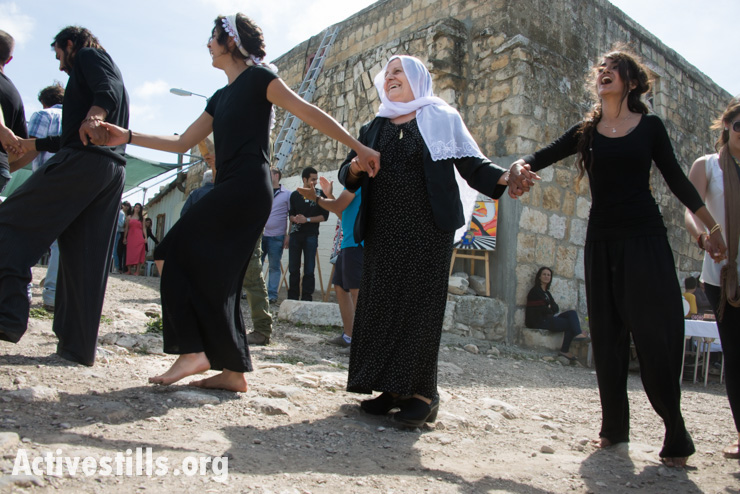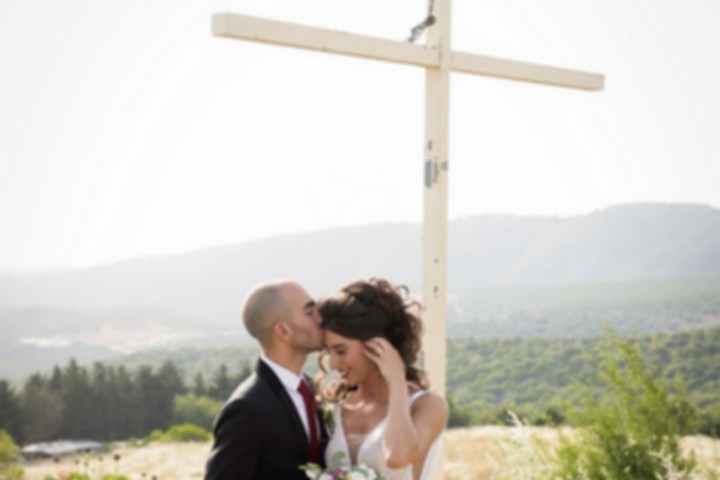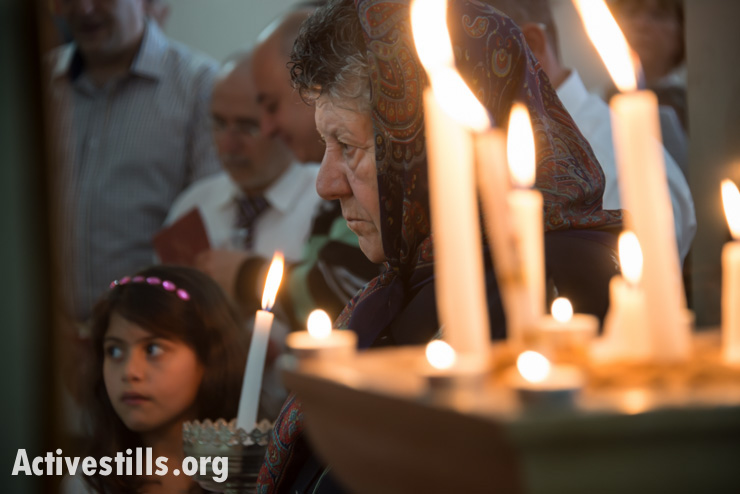Third-generation survivors of the Nakba are returning to the churches in the villages Israel destroyed in 1948 to hold religious ceremonies.
By Suha Arraf

Just over two weeks ago, Khaled Bisharat, son of famed journalist and author Odeh Bisharat, was married in a church in the village of Ma’alul. It was a wedding like any other, apart from one fact: Ma’alul, which lies just four miles southwest of Nazereth, was destroyed by Israel in the 1948 war, and most of its displaced residents fled to the town of Yafa an-Naseriyye.
The wedding is part of a trend: third-generation survivors of the Nakba are returning to their destroyed villages to hold religious ceremonies, including baptisms, weddings, and burials.
“I think that there will be a trend of holding weddings there,” said Odeh Bisharat. “My son is the second person to get married in Ma’alul. A week earlier, someone from the Salem family was married in the church, and there will be several more weddings in the village.”
Bisharat said that the decision was entirely Khaled’s.
Returning to Iqrit
Haitham Sbeit, 30, was born to a family that was expelled from the village of Iqrit and now lives in Haifa. Two months ago, he held his wedding at the church in Iqrit. “It’s not even a question for me, it’s very obvious,” said Sbiet. “I am a son of Iqrit. Iqrit is everything for me. Ever since I remember myself, I have been there every year for summer camp, Christmas and Easter ceremonies, and burials of family members and others. All my life I have been hoping to return there.”
Sbeit’s family history revolves around Iqrit. “My parents are refugees. They were born in Iqrit, moved to Rameh, and then to Haifa. I was born in Haifa, they then moved to Nazareth, and a year ago they moved to Tarshiha – as close as possible to our home in Iqrit,” he said. “We are refugees, moving time and time again.”
Sbeit took his partner Lina, a social worker originally from the village of Eilaboun, on a third date to Iqrit. “If the person I am going to spend my life with does not understand what Iqrit means to me and can’t feel what I feel, she is not right for me,” said Sbeit. “It’s a kind of test, and I was happy that Lina fell in love with the place and became an activist there.”
Sbeit is not the first person in his family to take his partner on a date in Iqrit. His uncle, George, took Shadia, who would later become his wife, on a date there over 25 years ago.
Shadia Sbeit, 47, who lives in the village of Kafr Yasif, remembers the day like it was yesterday. “I took all the clothes out of my closet to look for something nice to wear,” she said. “I wore my fancy leather boots. I was so excited because I hardly knew George. I liked him and wanted the relationship to work. He picked me up and we started driving north. I thought he was taking me to a romantic restaurant, he didn’t tell me where we were going.”
At a certain point, George stopped the car and Shadia found herself in an abandoned village, marching toward a church. “It was winter, and I was wearing my leather boots,” recalled Shadia. “I stepped in manure but continued marching up the hill until we got to the church. George told me excitedly about the place. It was at that moment that I understood that this was central to his life. I fell in love with the place and the people there, and since then I have become an activist who takes foreigners on tours of the area, I help run the summer camp, and take part in the ceremonies.”

Sbeit describes how his wife’s family, who is from Eilabun and has never been to a depopulated Palestinian village before, was just as emotional as his family at the wedding ceremony. “We decorated the church, then danced dabkeh in the courtyard, and drank arak and whiskey,” recalled Sbeit. “The site of the depopulated village with the ruins and the trees was astounding. On one side, you see the border with Lebanon, and on the other side you see the sea,” he said. “My dad and uncle had to beg the guests to leave the village and go to the party hall.”
Suheil Khoury, second generation to the Nakba and originally from Iqrit, lives in Nazareth today. He has been serving as a priest since 1987 and today preaches at the church in Tur’an, just north of Nazareth. He volunteers to officiate the weddings, funerals, and baptisms for the residents of his home village.
He said the first wedding to take place in Iqrit after the Nakba was in 1972 under a fig tree, because Israeli police prevented the ceremony from happening at the church. Since then, the church has been renovated, and couples have been able to get married there.
“We have buried at least 150 Iqrit residents at the village graveyard from the time I became a priest,” said Khoury. For him, opening the gates of the church is his contribution to the community. “This is the only home we have left,” he said.
Other than Christmas and Easter, he holds a church service there the first Saturday of every month. “The three most important phases in a person’s life are birth, marriage and death. It’s important for us to be able to experience all three in our village.”
‘We don’t want to return to our village in a casket’
The phenomenon of holding weddings, funerals and holiday services exists not only in Iqrit and Ma’alul — which are only two of 531 villages that Israel destroyed upon its founding in 1948 — but in other destroyed villages, like Bir’im, al-Bassa and many others.
Khoury’s dream of returning to the village, which many of the village elders share, came true seven years ago when a group of young Palestinians decided to go back and live in the church – the only building that survived the Nakba. Sbeit was one of those behind the idea: “Our summer camps here played a significant role in shaping our consciousness, as third generation to the Nakba,” he said. “Every year, we would sleep, eat, study and play there for an entire week.”
Then, seven years ago, after a successful summer camp session, they decided to make their presence permanent. “We told ourselves ‘Enough, we can’t keep crying over ruins, we have to do something,’” said Sbiet. “We created a Facebook group named ‘Iqrit’ and decided to return. We started, [a group of] 15 young men and women, to sleep at the church. Each person would go to work or university and then return to Iqrit. There was no electricity. We used candles and a generator. It was difficult. We started taking shifts so that there are at least three of us there every night.”

Sbeit’s first religious ceremony in Iqrit was in 2001 at his grandmother’s funeral. The day of her burial is etched in his memory and has become a formative event. “I will never forget the sight of my father, uncles and the village elders crying. We opened the casket and they sprinkled dirt on her face and clothes. The priest said a prayer and then they closed the casket. I was a kid and didn’t understand the meaning of returning there only when you’re dead. My friends and I decided that we will not go back in caskets, only to be buried there. We wanted to return while we are still alive, and this is what ended up happening.”
Shadia, Haitham’s aunt, explains that the burial in Iqrit has solved a real problem for the residents of the village. Many, who now live in Rameh, Kafr Yasif and Haifa, had difficulty in finding burial spaces in the cities they fled to. “We are refugees, after all, and the burial grounds belong to the original residents. People were doing us a favor by offering us a grave. Even in our death, we remain refugees.”
Shadia herself had her kids baptized in Iqrit 10 years ago, and one day they will also get married there. “Our parents, who experienced the occupation and became refugees, feared Israel. They instilled this fear in us. When I went to university, they constantly urged me not to get involved politically, or else I wouldn’t find a job. The third generation to the Nakba is braver, fearless. They are better educated, and engage with Israelis at eye level.”
Sbeit reaffirms Shadia’s statement. “We are not afraid,” he said. “We have the right to return to our village, and it’s every refugee’s right to return to where they are from. Nobody understands what it’s like to be displaced from your land, to be left hanging, waiting on other people’s favors to find a place to live or to be buried. It’s like a scar that never heals,” he said. “I will be the first to build a house in Iqrit, as soon as the legal matter is settled.”
A version of this article was first published in Hebrew, on Local Call. Read it here.
